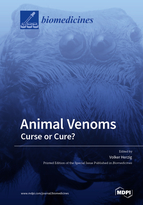Animal Venoms–Curse or Cure?
A special issue of Biomedicines (ISSN 2227-9059). This special issue belongs to the section "Drug Discovery, Development and Delivery".
Deadline for manuscript submissions: closed (30 April 2020) | Viewed by 84247
Special Issue Editor
Special Issue Information
Dear Colleagues,
It is estimated that about 15% of all animals spread across the majority of lineages are venomous. Animals use venom for various purposes including prey capture, predator deterrence, sexual combat and the provision of food for their offspring. Humans have always been fascinated by venomous animals, albeit in a Janus-faced way. On the one hand, venomous animals have gained a fearsome reputation in the public media, which is further boosted by an annual global death toll in the hundreds of thousands (with many more cases of permanent disablement) with the leading cause being tropical snakes. For this reason, snake envenomation has recently been classified by the World Health Organization as a neglected tropical disease. On the other hand, a growing global scene of enthusiasts in industrialized countries is keeping venomous animals such as snakes, spiders, scorpions, and centipedes in captivity as pets. The (also venomous) honeybees are even used as production animals in agriculture for the pollination of a wide variety of crops, which ensures the survival of billions of people and has the added benefit of yielding delicious honey. Furthermore, recent scientific research focused on exploiting animal venoms for the benefit of humanity in form of novel therapeutics or biopesticides.
This Special Issue will illuminate both the deleterious beneficial side effects of animal venoms and we invite the submission of all research or review papers dealing with this topic.
Dr. Volker Herzig
Guest Editor
Manuscript Submission Information
Manuscripts should be submitted online at www.mdpi.com by registering and logging in to this website. Once you are registered, click here to go to the submission form. Manuscripts can be submitted until the deadline. All submissions that pass pre-check are peer-reviewed. Accepted papers will be published continuously in the journal (as soon as accepted) and will be listed together on the special issue website. Research articles, review articles as well as short communications are invited. For planned papers, a title and short abstract (about 100 words) can be sent to the Editorial Office for announcement on this website.
Submitted manuscripts should not have been published previously, nor be under consideration for publication elsewhere (except conference proceedings papers). All manuscripts are thoroughly refereed through a single-blind peer-review process. A guide for authors and other relevant information for submission of manuscripts is available on the Instructions for Authors page. Biomedicines is an international peer-reviewed open access monthly journal published by MDPI.
Please visit the Instructions for Authors page before submitting a manuscript. The Article Processing Charge (APC) for publication in this open access journal is 2600 CHF (Swiss Francs). Submitted papers should be well formatted and use good English. Authors may use MDPI's English editing service prior to publication or during author revisions.
Keywords
- venom
- toxin
- venoms to drugs/therapeutics
- biopesticide
- antivenom
- toxicity
- lethality
- bioprospecting
- envenomation







